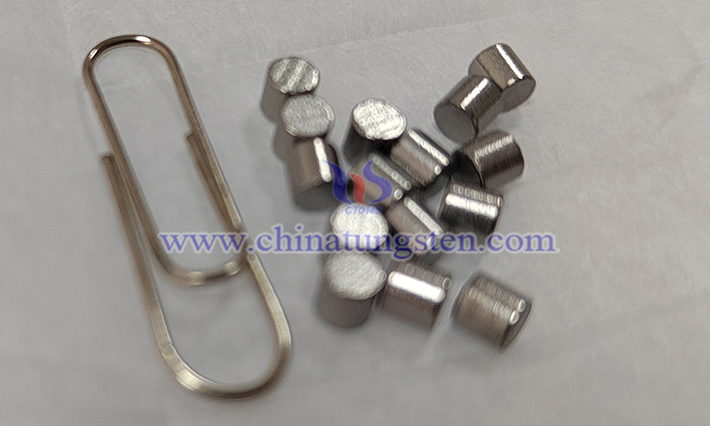Factors Affecting the Uniformity of Thermal Emission of Barium Tungsten Electrode
- Details
- Category: Tungsten Information
- Published on Friday, 30 May 2025 17:43
The uniformity of thermal emission of barium tungsten electrode is the core indicator that determines its performance stability and application effect, and directly affects the working efficiency and life of electronic devices (such as microwave tubes and X-ray tubes). Its uniformity is jointly regulated by multi-dimensional influencing factors such as material composition, preparation process, working environment and surface state.

1. Material Composition and Microstructure
1.1 Barium Tungsten Ratio Regulation
Work Function Optimization: Barium (Ba) doping can significantly reduce the work function of tungsten (W), but the barium content needs to be precisely controlled. Excessive barium leads to uneven distribution of surface atoms, causing local emission to be too strong or insufficient; insufficient barium cannot effectively reduce the work function and reduce the overall emission efficiency.
Dynamic Balance Mechanism: Barium atoms diffuse through the pores of the matrix to the surface to form a covering layer, and its evaporation and replenishment need to maintain a dynamic balance. The operating temperature needs to be optimized to balance the evaporation rate (to prevent the barium from being lost too quickly) and the diffusion rate (to ensure that the surface cover is continuously renewed).
1.2 Additives and Rare Earth Elements
Grain Refinement: Adding rare earth elements such as lanthanum (La) and cerium (Ce) can refine the grains, reduce grain boundary defects, and improve surface density and stability.
Resistance to Thermal Fatigue: Rare earth additives can enhance the grain boundary bonding force, inhibit grain growth and surface reconstruction at high temperatures, and extend the life of the electrode.
1.3 Pore structure Optimization
Aperture Distribution: The porous matrix prepared with spherical tungsten powder (such as by radio frequency plasma spheroidization technology) has a more uniform pore size distribution and smooth channels, which significantly improves the emission uniformity.
Connectivity: The highly connected pore structure promotes the diffusion of barium atoms and reduces local concentration differences, thereby improving the emission uniformity.
2. Preparation Process
2.1 Sintering Process Parameters
Temperature Control: High temperature sintering (such as 1500-1700°C) promotes the diffusion and fusion of barium and tungsten, improves the electrode density, reduces the porosity, and forms a smooth surface to reduce electron scattering.
Atmosphere Selection: Reducing atmosphere (such as hydrogen) or vacuum sintering can prevent the oxidation of barium and tungsten and ensure the surface purity.
2.2 Impregnation and Activation Process
Liquid Phase Impregnation: Compared with the traditional solid phase method, the liquid phase method can prepare single-phase aluminates (such as BaO·Al₂O₃), reduce the formation of impurities, and increase the barium yield and emission current density.
Activation Reaction: When heated at high temperature for the first time, barium compounds (such as BaO) react with tungsten to reduce (6BaO + W → 3Ba + Ba₃WO₆), release metal barium and form a surface coating.
2.3 Surface Treatment Technology
Chemical Cleaning: Acid or alkaline washing removes surface oxides and contaminants and restores surface smoothness.
Heat Treatment: high temperature annealing eliminates residual stress, promotes surface atomic rearrangement, and optimizes microstructure.

3. Working Environment
3.1 Temperature and Thermal Management
Working temperature range: precise temperature control is required to avoid barium evaporation too fast (high temperature) or insufficient diffusion (low temperature). Temperature fluctuations will cause emission current fluctuations and affect uniformity.
Thermal cycle effect: thermal stress caused by frequent switching on and off may cause microcracks or grain boundary fractures, and the electrode design needs to be optimized to reduce stress concentration.
3.2 Gas Composition and Vacuum Degree
Oxidation risk: active gases such as oxygen and water vapor will react with barium to form oxides (such as BaO, WO₃), destroying the surface smoothness and causing uneven emission.
Vacuum degree requirements: high vacuum environment reduces gas adsorption and chemical reactions, maintains surface stability; low vacuum accelerates surface degradation and shortens electrode life.
3.3 Electric Field and Current Density
Field Emission Effect: the external electric field enhances emission by reducing the barrier height, but precise control is required to avoid local overload.
Current Density Balance: High current density accelerates surface loss, and a balance must be achieved between emission efficiency and life.
4. Surface State and Aging Mechanism
4.1 Surface Cleanliness
Influence of Pollutants: Surface pollutants (such as oxides and carbon deposition) increase electron scattering and reduce emission efficiency.
Dynamic Maintenance: Regular chemical cleaning and heat treatment can restore surface activity and extend electrode life.
4.2 Aging and Degradation
Barium Volatilization: Long-term high-temperature operation causes barium atoms to gradually volatilize, the surface coating becomes thinner, and the emission performance decreases.
Microstructural Degradation: Factors such as thermal stress and ion bombardment lead to grain coarsening and increased porosity, further exacerbating emission unevenness.
- Chinatungsten Online: www.tungsten.com.cn
- CTIA GROUP LTD: en.ctia.group
- Tungsten News & Price: www.ctia.com.cn
- Molybdenum News & Price: news.molybdenum.com.cn
- Tel.: 86 592 5129696; Email: sales@chinatungsten.com



 sales@chinatungsten.com
sales@chinatungsten.com